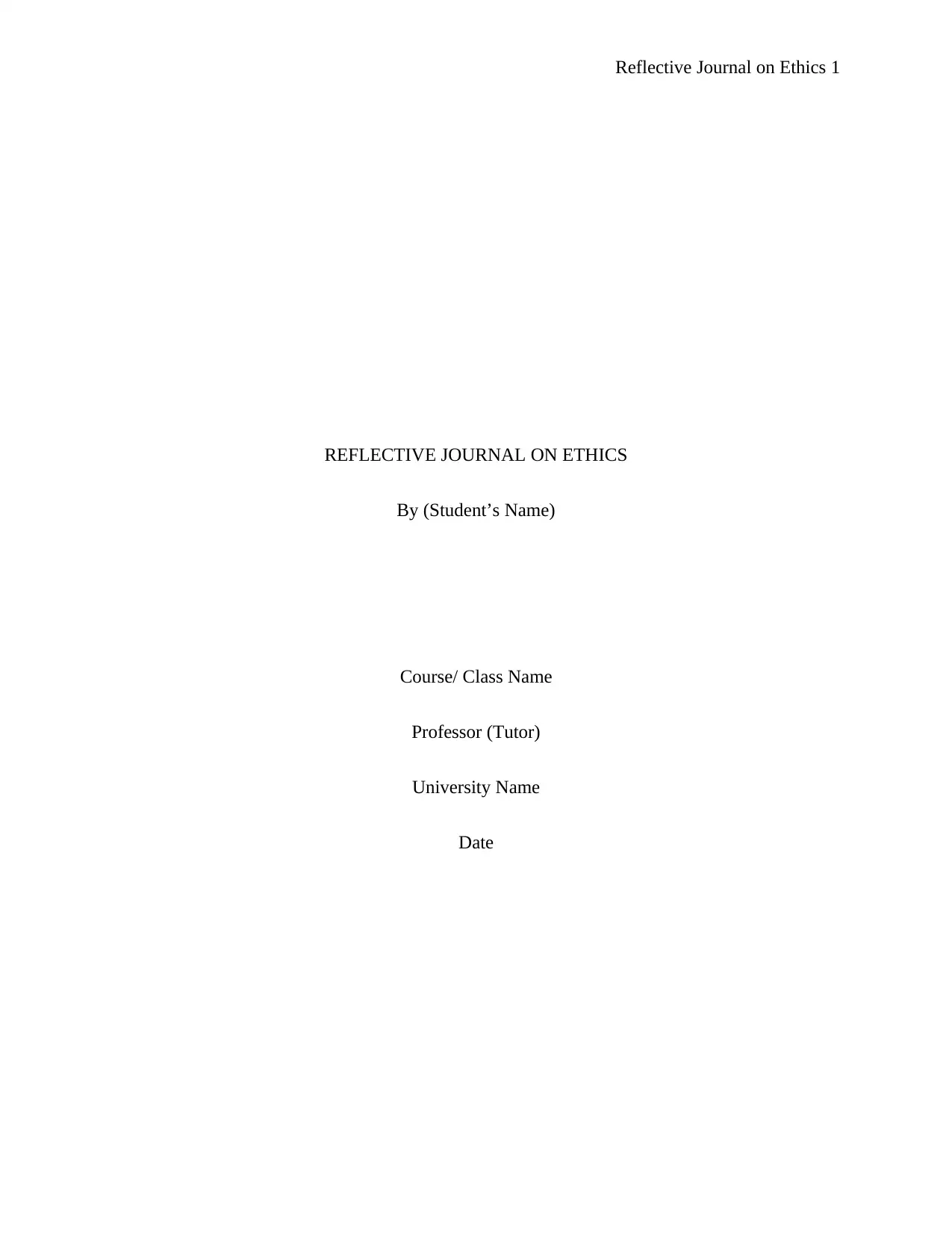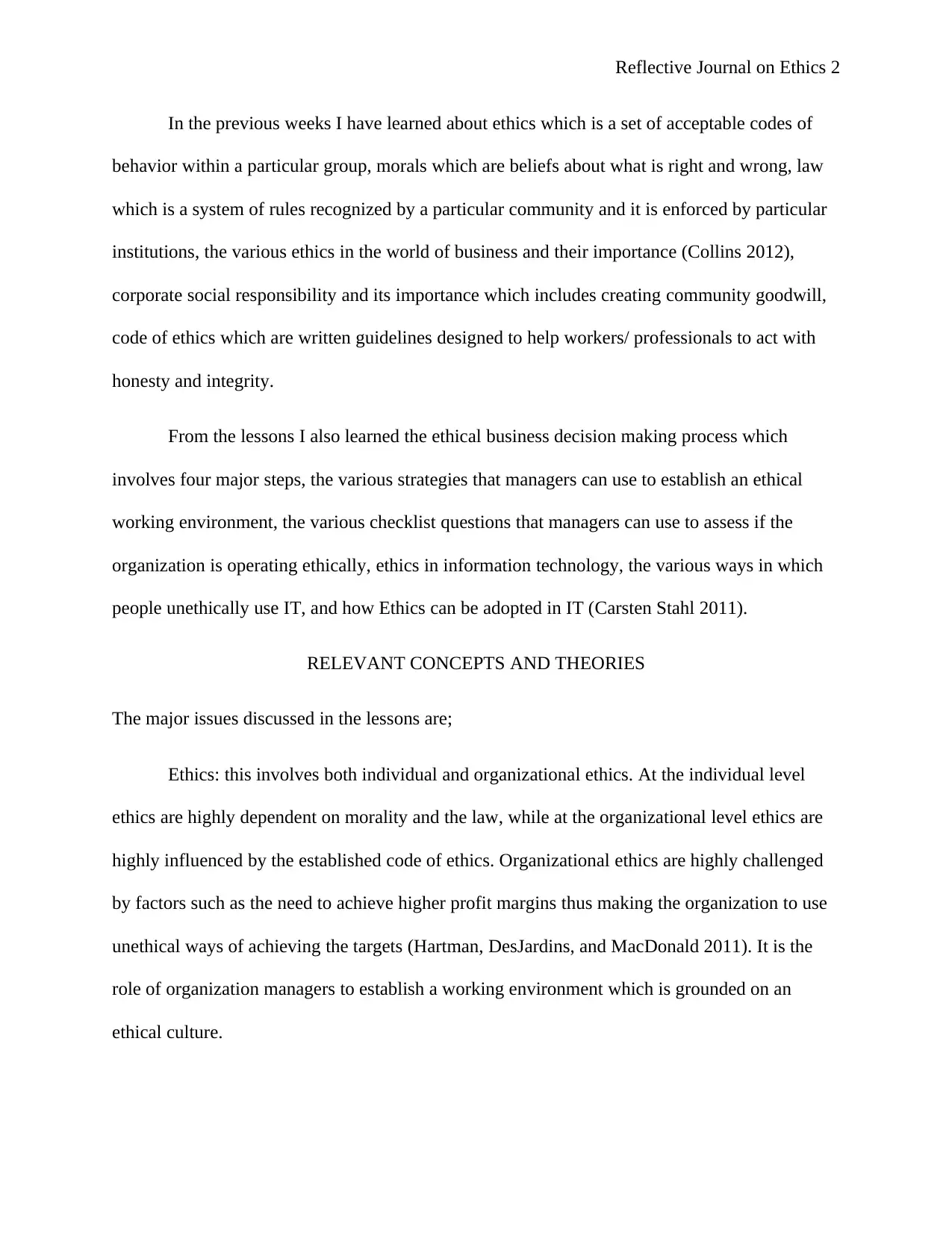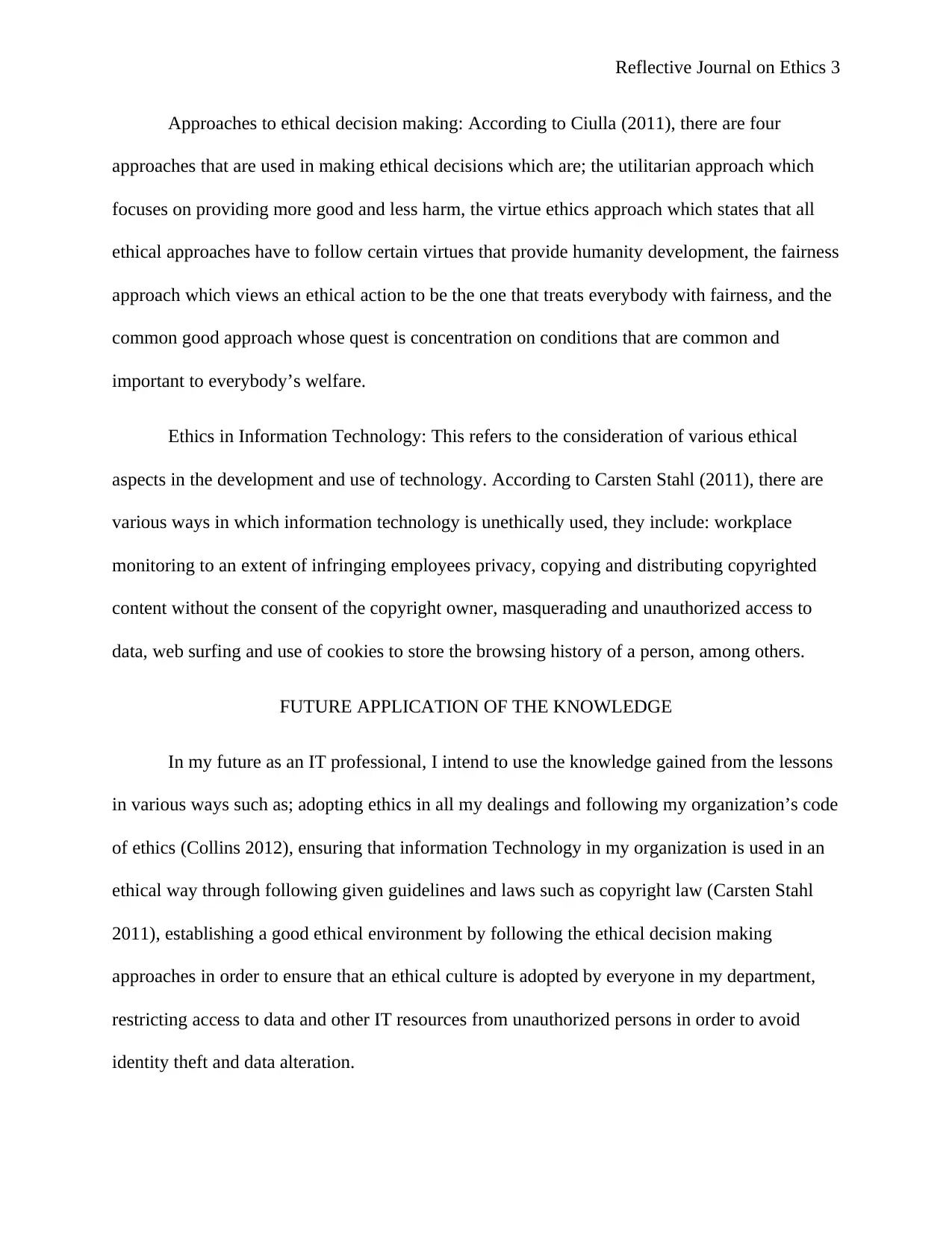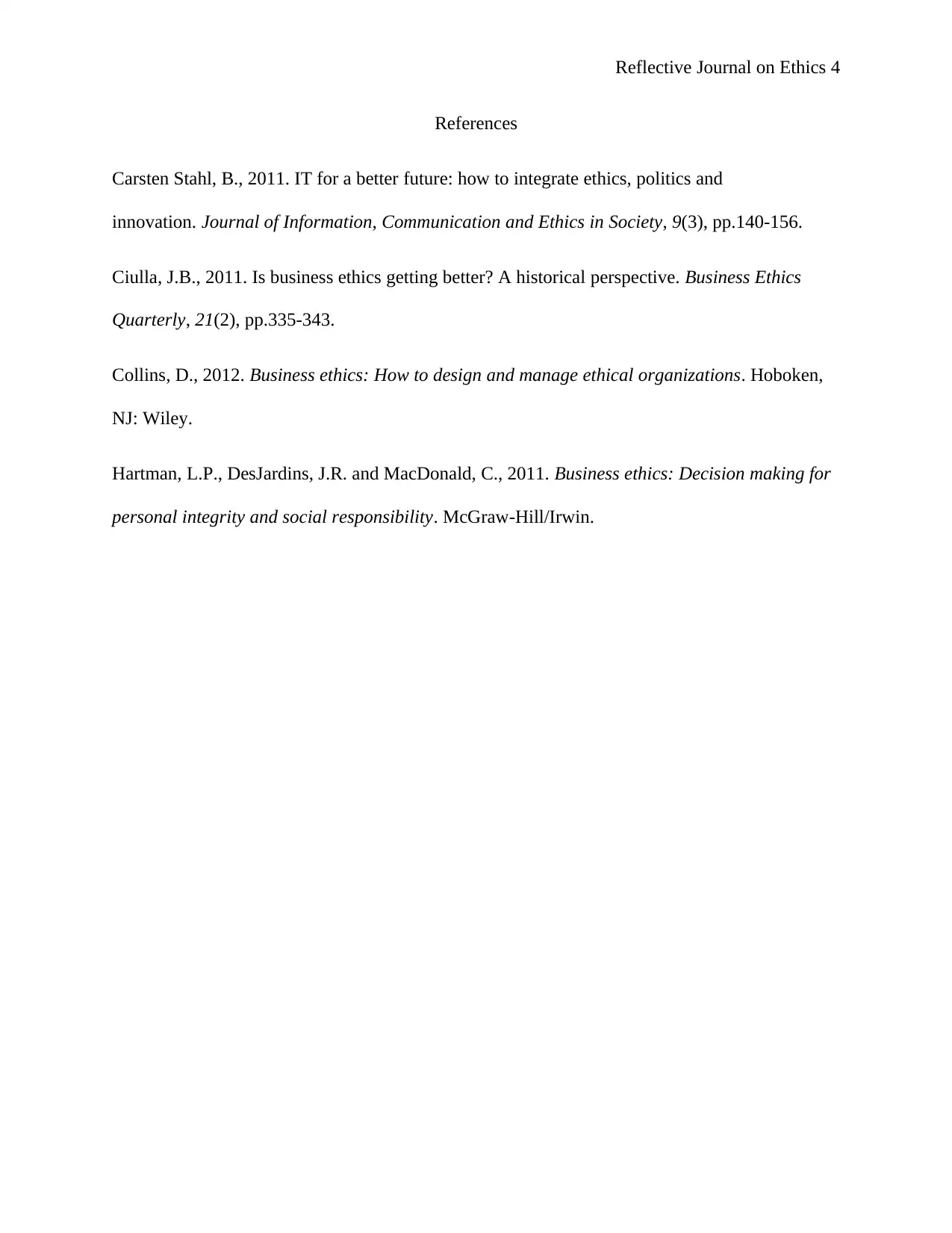ISY1000: Reflective Journal on Ethics in Information Technology
VerifiedAdded on 2023/06/09
|4
|767
|143
Journal and Reflective Writing
AI Summary
This is a reflective journal focusing on ethics in information technology. The journal covers key concepts learned, including individual and organizational ethics, approaches to ethical decision-making (utilitarian, virtue ethics, fairness, and common good), and ethics in information technology, highlighting unethical uses such as workplace monitoring and copyright infringement. The author discusses applying this knowledge as an IT professional by adhering to ethical codes, ensuring ethical IT usage, establishing an ethical environment, and restricting unauthorized data access. References to relevant journal articles are included to support the reflections and future applications of the learned concepts.

Reflective Journal on Ethics 1
REFLECTIVE JOURNAL ON ETHICS
By (Student’s Name)
Course/ Class Name
Professor (Tutor)
University Name
Date
REFLECTIVE JOURNAL ON ETHICS
By (Student’s Name)
Course/ Class Name
Professor (Tutor)
University Name
Date
Paraphrase This Document
Need a fresh take? Get an instant paraphrase of this document with our AI Paraphraser

Reflective Journal on Ethics 2
In the previous weeks I have learned about ethics which is a set of acceptable codes of
behavior within a particular group, morals which are beliefs about what is right and wrong, law
which is a system of rules recognized by a particular community and it is enforced by particular
institutions, the various ethics in the world of business and their importance (Collins 2012),
corporate social responsibility and its importance which includes creating community goodwill,
code of ethics which are written guidelines designed to help workers/ professionals to act with
honesty and integrity.
From the lessons I also learned the ethical business decision making process which
involves four major steps, the various strategies that managers can use to establish an ethical
working environment, the various checklist questions that managers can use to assess if the
organization is operating ethically, ethics in information technology, the various ways in which
people unethically use IT, and how Ethics can be adopted in IT (Carsten Stahl 2011).
RELEVANT CONCEPTS AND THEORIES
The major issues discussed in the lessons are;
Ethics: this involves both individual and organizational ethics. At the individual level
ethics are highly dependent on morality and the law, while at the organizational level ethics are
highly influenced by the established code of ethics. Organizational ethics are highly challenged
by factors such as the need to achieve higher profit margins thus making the organization to use
unethical ways of achieving the targets (Hartman, DesJardins, and MacDonald 2011). It is the
role of organization managers to establish a working environment which is grounded on an
ethical culture.
In the previous weeks I have learned about ethics which is a set of acceptable codes of
behavior within a particular group, morals which are beliefs about what is right and wrong, law
which is a system of rules recognized by a particular community and it is enforced by particular
institutions, the various ethics in the world of business and their importance (Collins 2012),
corporate social responsibility and its importance which includes creating community goodwill,
code of ethics which are written guidelines designed to help workers/ professionals to act with
honesty and integrity.
From the lessons I also learned the ethical business decision making process which
involves four major steps, the various strategies that managers can use to establish an ethical
working environment, the various checklist questions that managers can use to assess if the
organization is operating ethically, ethics in information technology, the various ways in which
people unethically use IT, and how Ethics can be adopted in IT (Carsten Stahl 2011).
RELEVANT CONCEPTS AND THEORIES
The major issues discussed in the lessons are;
Ethics: this involves both individual and organizational ethics. At the individual level
ethics are highly dependent on morality and the law, while at the organizational level ethics are
highly influenced by the established code of ethics. Organizational ethics are highly challenged
by factors such as the need to achieve higher profit margins thus making the organization to use
unethical ways of achieving the targets (Hartman, DesJardins, and MacDonald 2011). It is the
role of organization managers to establish a working environment which is grounded on an
ethical culture.

Reflective Journal on Ethics 3
Approaches to ethical decision making: According to Ciulla (2011), there are four
approaches that are used in making ethical decisions which are; the utilitarian approach which
focuses on providing more good and less harm, the virtue ethics approach which states that all
ethical approaches have to follow certain virtues that provide humanity development, the fairness
approach which views an ethical action to be the one that treats everybody with fairness, and the
common good approach whose quest is concentration on conditions that are common and
important to everybody’s welfare.
Ethics in Information Technology: This refers to the consideration of various ethical
aspects in the development and use of technology. According to Carsten Stahl (2011), there are
various ways in which information technology is unethically used, they include: workplace
monitoring to an extent of infringing employees privacy, copying and distributing copyrighted
content without the consent of the copyright owner, masquerading and unauthorized access to
data, web surfing and use of cookies to store the browsing history of a person, among others.
FUTURE APPLICATION OF THE KNOWLEDGE
In my future as an IT professional, I intend to use the knowledge gained from the lessons
in various ways such as; adopting ethics in all my dealings and following my organization’s code
of ethics (Collins 2012), ensuring that information Technology in my organization is used in an
ethical way through following given guidelines and laws such as copyright law (Carsten Stahl
2011), establishing a good ethical environment by following the ethical decision making
approaches in order to ensure that an ethical culture is adopted by everyone in my department,
restricting access to data and other IT resources from unauthorized persons in order to avoid
identity theft and data alteration.
Approaches to ethical decision making: According to Ciulla (2011), there are four
approaches that are used in making ethical decisions which are; the utilitarian approach which
focuses on providing more good and less harm, the virtue ethics approach which states that all
ethical approaches have to follow certain virtues that provide humanity development, the fairness
approach which views an ethical action to be the one that treats everybody with fairness, and the
common good approach whose quest is concentration on conditions that are common and
important to everybody’s welfare.
Ethics in Information Technology: This refers to the consideration of various ethical
aspects in the development and use of technology. According to Carsten Stahl (2011), there are
various ways in which information technology is unethically used, they include: workplace
monitoring to an extent of infringing employees privacy, copying and distributing copyrighted
content without the consent of the copyright owner, masquerading and unauthorized access to
data, web surfing and use of cookies to store the browsing history of a person, among others.
FUTURE APPLICATION OF THE KNOWLEDGE
In my future as an IT professional, I intend to use the knowledge gained from the lessons
in various ways such as; adopting ethics in all my dealings and following my organization’s code
of ethics (Collins 2012), ensuring that information Technology in my organization is used in an
ethical way through following given guidelines and laws such as copyright law (Carsten Stahl
2011), establishing a good ethical environment by following the ethical decision making
approaches in order to ensure that an ethical culture is adopted by everyone in my department,
restricting access to data and other IT resources from unauthorized persons in order to avoid
identity theft and data alteration.
⊘ This is a preview!⊘
Do you want full access?
Subscribe today to unlock all pages.

Trusted by 1+ million students worldwide

Reflective Journal on Ethics 4
References
Carsten Stahl, B., 2011. IT for a better future: how to integrate ethics, politics and
innovation. Journal of Information, Communication and Ethics in Society, 9(3), pp.140-156.
Ciulla, J.B., 2011. Is business ethics getting better? A historical perspective. Business Ethics
Quarterly, 21(2), pp.335-343.
Collins, D., 2012. Business ethics: How to design and manage ethical organizations. Hoboken,
NJ: Wiley.
Hartman, L.P., DesJardins, J.R. and MacDonald, C., 2011. Business ethics: Decision making for
personal integrity and social responsibility. McGraw-Hill/Irwin.
References
Carsten Stahl, B., 2011. IT for a better future: how to integrate ethics, politics and
innovation. Journal of Information, Communication and Ethics in Society, 9(3), pp.140-156.
Ciulla, J.B., 2011. Is business ethics getting better? A historical perspective. Business Ethics
Quarterly, 21(2), pp.335-343.
Collins, D., 2012. Business ethics: How to design and manage ethical organizations. Hoboken,
NJ: Wiley.
Hartman, L.P., DesJardins, J.R. and MacDonald, C., 2011. Business ethics: Decision making for
personal integrity and social responsibility. McGraw-Hill/Irwin.
1 out of 4
Related Documents
Your All-in-One AI-Powered Toolkit for Academic Success.
+13062052269
info@desklib.com
Available 24*7 on WhatsApp / Email
![[object Object]](/_next/static/media/star-bottom.7253800d.svg)
Unlock your academic potential
Copyright © 2020–2025 A2Z Services. All Rights Reserved. Developed and managed by ZUCOL.




